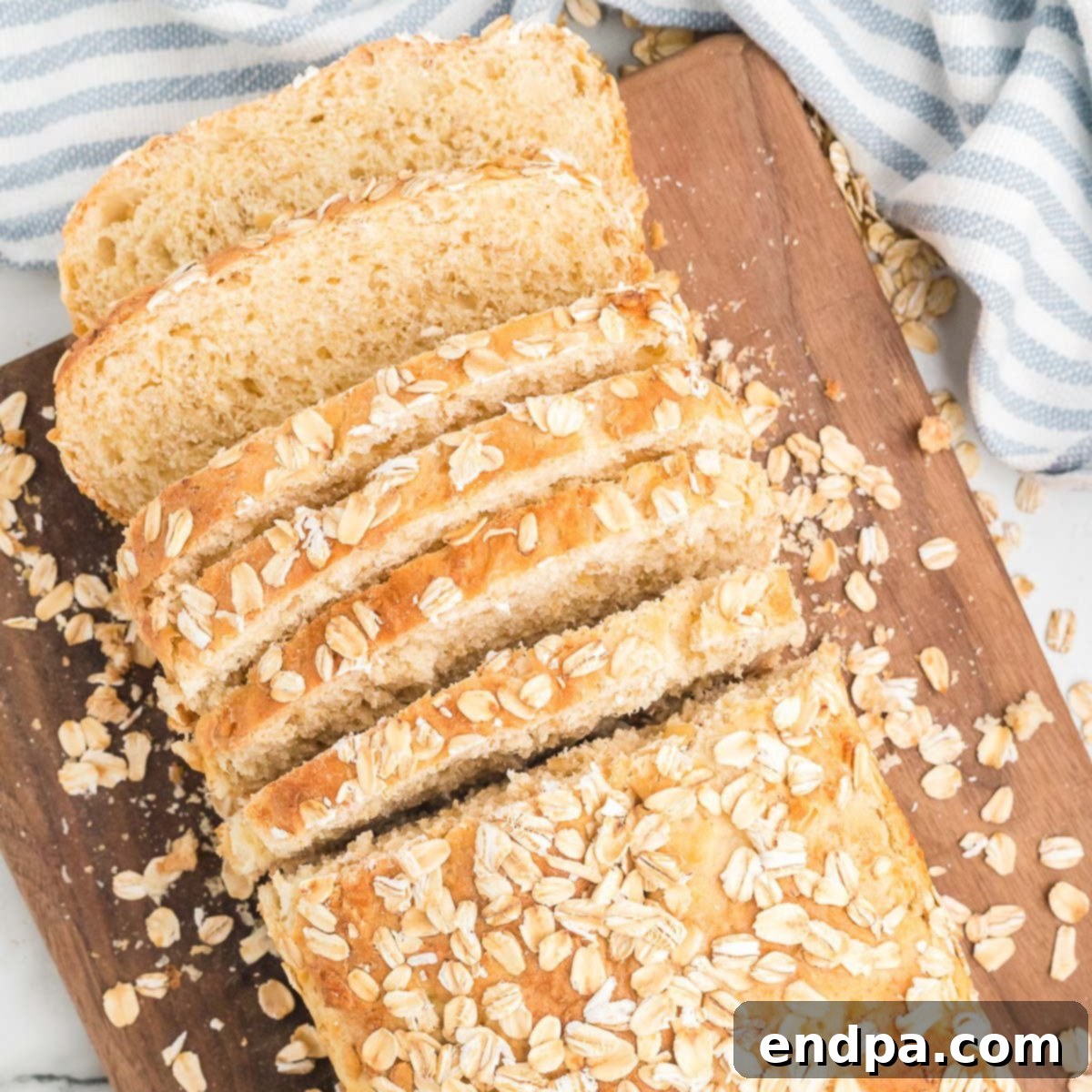Homemade Oatmeal Bread: Your New Favorite Pantry Staple Recipe
There’s nothing quite like the aroma of freshly baked bread filling your home. And when it comes to wholesome, comforting loaves, this **Oatmeal Bread recipe** stands out. Crafted from simple, readily available *pantry staples*, this delightful bread is perfectly sweetened with a touch of honey, boasting a wonderfully soft interior and a pleasing texture that makes it irresistible. It’s more than just a bread; it’s an experience.
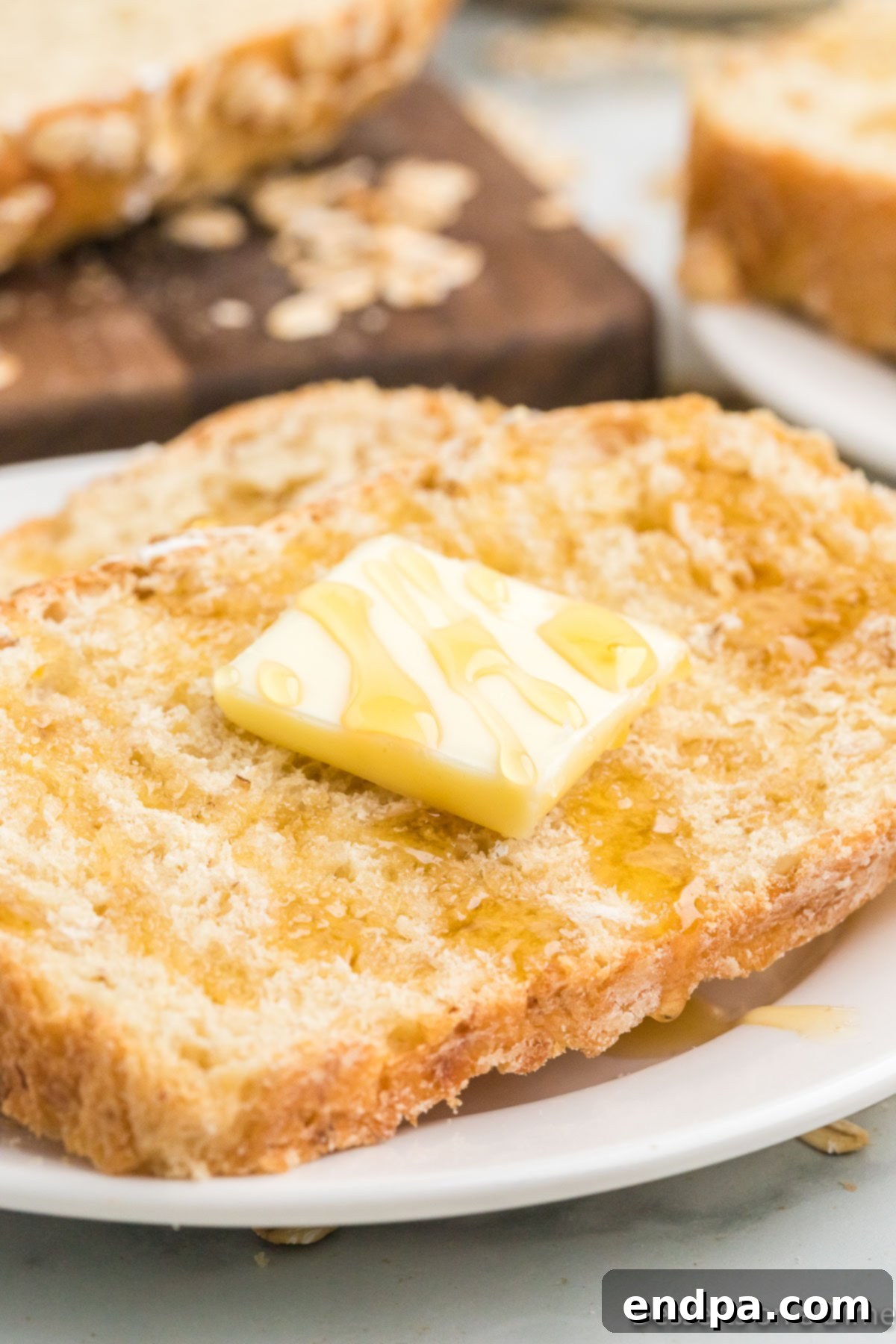
While often categorized alongside quick bread recipes for its comforting appeal, our featured oatmeal bread utilizes yeast, resulting in a beautifully risen, airy loaf with a satisfying chew. This recipe is surprisingly easy to master, making homemade bread baking accessible even for beginners. Its mild, subtly sweet flavor pairs exceptionally well with any meal or snack. My family has enjoyed this for years, whether slathered with jelly for a sweet treat or transformed into hearty sandwiches. It’s also fantastic simply toasted with butter – truly a versatile addition to your culinary repertoire.
Unlike richer, sweeter options such as Cinnamon Bread or Cherry Bread, this oatmeal loaf offers a milder, more wholesome taste. If you’re a fan of baking with oats, you’ll also adore our other oat-inspired treats like 3-Ingredient Oatmeal Cookies, No-Bake Peanut Butter Oatmeal Bars, and classic Oatmeal Scotchies. And don’t forget the comforting Oatmeal Cake and beloved Oatmeal Raisin Cookies!
What You’ll Find in This Post: All About Oatmeal Bread
- Why You’ll Adore This Oatmeal Bread Recipe
- Essential Ingredients for Wholesome Oatmeal Bread
- Customizing Your Loaf: Substitutions and Additions
- Baking Perfection: How to Make Homemade Oatmeal Bread
- Troubleshooting Common Bread Baking Issues
- Serving Suggestions for Your Freshly Baked Loaf
- Storage and Freezing Made Easy
- Frequently Asked Questions About Oatmeal Bread
- More Delicious Bread Recipes to Explore
- Full Oatmeal Bread Recipe Card
Why You’ll Adore This Homemade Oatmeal Bread Recipe
There are countless reasons why this particular oatmeal bread recipe consistently earns rave reviews from home bakers:
- **Effortlessly Simple:** Despite being a yeast bread, the process is straightforward and easy to follow, making it perfect for both novice and experienced bakers.
- **Pantry-Friendly Ingredients:** You likely have most, if not all, of the basic ingredients in your kitchen right now, eliminating the need for special trips to the store.
- **Unforgettable Taste & Texture:** The combination of wholesome oats and delicate honey creates a unique flavor profile and an incredibly tender crumb with just the right amount of chew. It’s truly a delight for the senses.
- **Freezer-Friendly:** This bread freezes beautifully, allowing you to bake ahead and enjoy a fresh loaf whenever the craving strikes. It’s perfect for meal prepping or unexpected guests.
- **Nutritional Boost:** Oats add dietary fiber, vitamins, and minerals, making this a more wholesome alternative to many store-bought breads.
- **Customizable Canvas:** This basic recipe is a fantastic starting point for endless variations. Add dried fruits, nuts, or seeds to make it your own.
- **Comforting & Inviting Aroma:** The smell of fresh bread baking is undeniably one of life’s simple pleasures, creating a warm and welcoming atmosphere in your home.
Essential Ingredients for Wholesome Oatmeal Bread
Crafting this hearty oatmeal bread requires a few simple ingredients, each playing a crucial role in achieving its perfect texture and flavor. Quality ingredients make all the difference in bread baking.
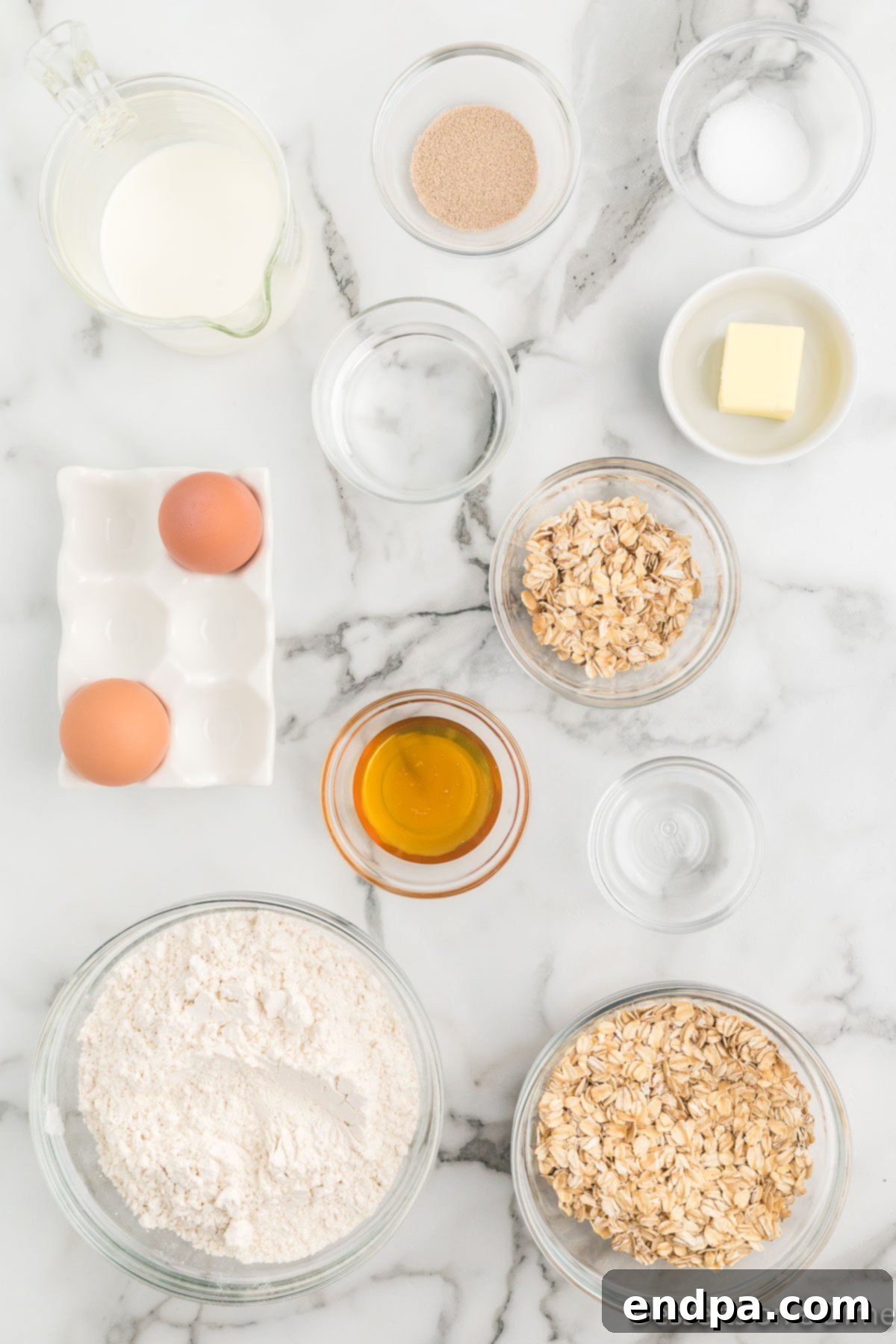
- **Rolled Oats:** Essential for the bread’s namesake texture and flavor. Use old-fashioned rolled oats, not quick or instant oats, as they absorb liquids differently and contribute to a more substantial crumb.
- **Unsalted Butter:** Softened butter adds richness, tenderness, and a delightful flavor to the dough. Using unsalted allows you to control the overall salt content.
- **Milk:** Boiled to a low simmer and then cooled, milk enriches the dough, making the bread softer and contributing to a beautiful golden crust. The heat helps to “scald” the milk, which deactivates enzymes that can interfere with gluten development.
- **Warm Water:** Crucial for activating the dry active yeast. Ensure it’s between 105-115°F (40-46°C) – too cold and the yeast won’t activate; too hot and it will kill the yeast.
- **Dry Active Yeast:** The magic ingredient that makes the bread rise, creating that wonderful airy structure. Make sure your yeast is fresh and active!
- **All-Purpose Flour:** Provides the necessary structure for the bread. While you can experiment with whole wheat flour for a denser, more rustic loaf, all-purpose creates a classic, tender texture.
- **Honey:** Our natural sweetener of choice, honey not only adds a lovely depth of flavor but also helps to keep the bread moist and contributes to its golden-brown crust.
- **Salt:** Essential for enhancing flavor and controlling yeast activity. Don’t skip it!
- **Large Egg:** At room temperature, an egg adds richness, helps bind the ingredients, and contributes to a softer crumb and golden hue.
For the Topping:
- **Large Egg (for egg wash):** Whisked with a little water, this creates a beautiful, shiny, golden crust.
- **Rolled Oats:** A sprinkle on top before baking adds visual appeal and an extra hint of oat flavor and texture.
The complete, detailed ingredient list with precise measurements can be found in the recipe card at the very end of this post.
Customizing Your Loaf: Delicious Substitutions and Additions
One of the joys of baking homemade bread is the freedom to personalize it. This oatmeal bread recipe is incredibly versatile, allowing for a variety of additions and substitutions to suit your taste or dietary needs. Here are some ideas to inspire you:
- Raisins or Dried Fruit: For a touch of sweetness and chewiness, incorporate up to 1 cup of raisins, dried cranberries, chopped apricots, or other dried fruits into the dough. Add them after the first rise, kneading them gently into the dough until evenly distributed.
- Nuts: Enhance the texture and add a nutty flavor by mixing in about ½ to 1 cup of chopped pecans, walnuts, or even sliced almonds. Introduce them to the dough at the same stage as dried fruits, after the initial rise.
- Seeds: Boost the nutritional value and add a subtle crunch with flax seeds, chia seeds, sunflower seeds, or pumpkin seeds. Mix ¼ to ½ cup into the dry ingredients for an earthy flavor and added fiber.
- Spices: For a warmer, spiced loaf, consider adding ½ teaspoon of ground cinnamon or a pinch of nutmeg to your dry ingredients. This is especially lovely during cooler months.
- Sweeteners: While honey is recommended, you can substitute it with an equal amount of maple syrup for a different flavor profile, or even brown sugar for a richer, molasses-like note.
- Flour Variations: For a denser, heartier loaf, you can substitute up to half of the all-purpose flour with whole wheat flour. Keep in mind that whole wheat flour absorbs more liquid, so you might need to add a touch more milk or water until the dough reaches the right consistency.
- Dairy-Free Option: If you need a dairy-free bread, swap regular milk for a plant-based alternative like unsweetened almond milk or oat milk, and use a dairy-free butter substitute.
Always remember that additions can affect the dough’s hydration, so adjust liquids slightly if necessary to maintain a pliable, non-sticky dough. Experiment and discover your favorite combinations!

Baking Perfection: How to Make Homemade Oatmeal Bread
Creating this delicious yeast-leavened oatmeal bread is a rewarding process. Follow these detailed steps to achieve a perfect loaf every time:
- Prepare Your Pan: Begin by greasing a 9×5 inch loaf pan thoroughly. You can also line it with parchment paper, leaving an overhang on the longer sides to easily lift the finished bread out. Set it aside.
- Soak the Oats: In a large mixing bowl, combine the rolled oats and softened butter. Pour the warm, simmered milk over this mixture. Stir gently to combine everything, ensuring the oats are well-coated. Let this mixture sit and cool to room temperature for about 1 to 2 hours. This soaking allows the oats to soften and absorb moisture, contributing to the bread’s tender crumb.
- Activate the Yeast: In a separate large mixing bowl, add the warm water (ensure it’s between 105-115°F or 40-46°C). Sprinkle the dry active yeast over the water. Stir gently with a wooden spoon and let it sit for 3-5 minutes. You should see the mixture become foamy and bubbly, indicating that the yeast is active and alive.
- Combine Wet Ingredients: To the activated yeast mixture, add the honey and salt. Stir these ingredients thoroughly, either by hand with a sturdy spoon or using an electric mixer with the dough hook attachment on low speed. Next, incorporate the cooled oatmeal and butter mixture, along with the room-temperature large egg, into the yeast mixture. Beat until all components are well combined.
- Add Flour Gradually: With the mixer speed on low (or by hand), slowly add the all-purpose flour, one cup at a time, until it is just combined and a shaggy dough forms. Mix in the remaining salt if not added earlier. Be careful not to overmix at this stage; just enough to bring the dough together.
- Knead the Dough: Increase the mixer speed to medium-low and knead the dough for about 5-7 minutes, or knead by hand on a lightly floured surface for 8-10 minutes. The dough should become smooth, elastic, and pass the “windowpane test” (where a small piece can be stretched thin enough to see light through it without tearing). Once kneaded, form the dough into a ball and place it in a lightly greased bowl, turning it once to coat all sides.
- First Rise (Bulk Fermentation): Cover the bowl with plastic wrap or a clean kitchen towel and allow the dough to rise in a warm, draft-free place until it doubles in size. This can take anywhere from 1 to 2 hours, depending on the temperature of your kitchen.
- Punch Down & Shape: Once doubled, gently punch the dough down to release the air. Remove it from the bowl and transfer it to a lightly floured surface. Knead it briefly for a minute or two, then shape the dough into a compact loaf that fits neatly into your prepared 9×5 inch loaf pan.
- Second Rise (Proofing) & Topping: Place the shaped loaf in the prepared pan. In a small bowl, whisk together the remaining large egg with a tablespoon of water to create an egg wash. Brush this generously over the top of the loaf, then sprinkle evenly with extra rolled oats. Cover the pan loosely with plastic wrap or a towel and allow the loaf to rise again in a warm place until it has nearly doubled in size and looks puffy. Be careful not to let it rise excessively above the rim of the pan, as it can overflow during baking.
- Bake to Golden Perfection: Preheat your oven to 375°F (190°C). Bake the bread for 30 to 40 minutes, or until the top is beautifully golden brown and the internal temperature reaches 200-210°F (93-99°C). If the crust browns too quickly, you can loosely tent it with aluminum foil for the last 10-15 minutes of baking.
- Cool Completely: Once baked, remove the pan from the oven. Let the bread cool in the pan for about 10-15 minutes before carefully removing it and transferring it to a wire rack to cool completely. Slicing warm yeast bread can result in a gummy texture, so patience is key! Once fully cooled, slice and enjoy your homemade oatmeal bread!

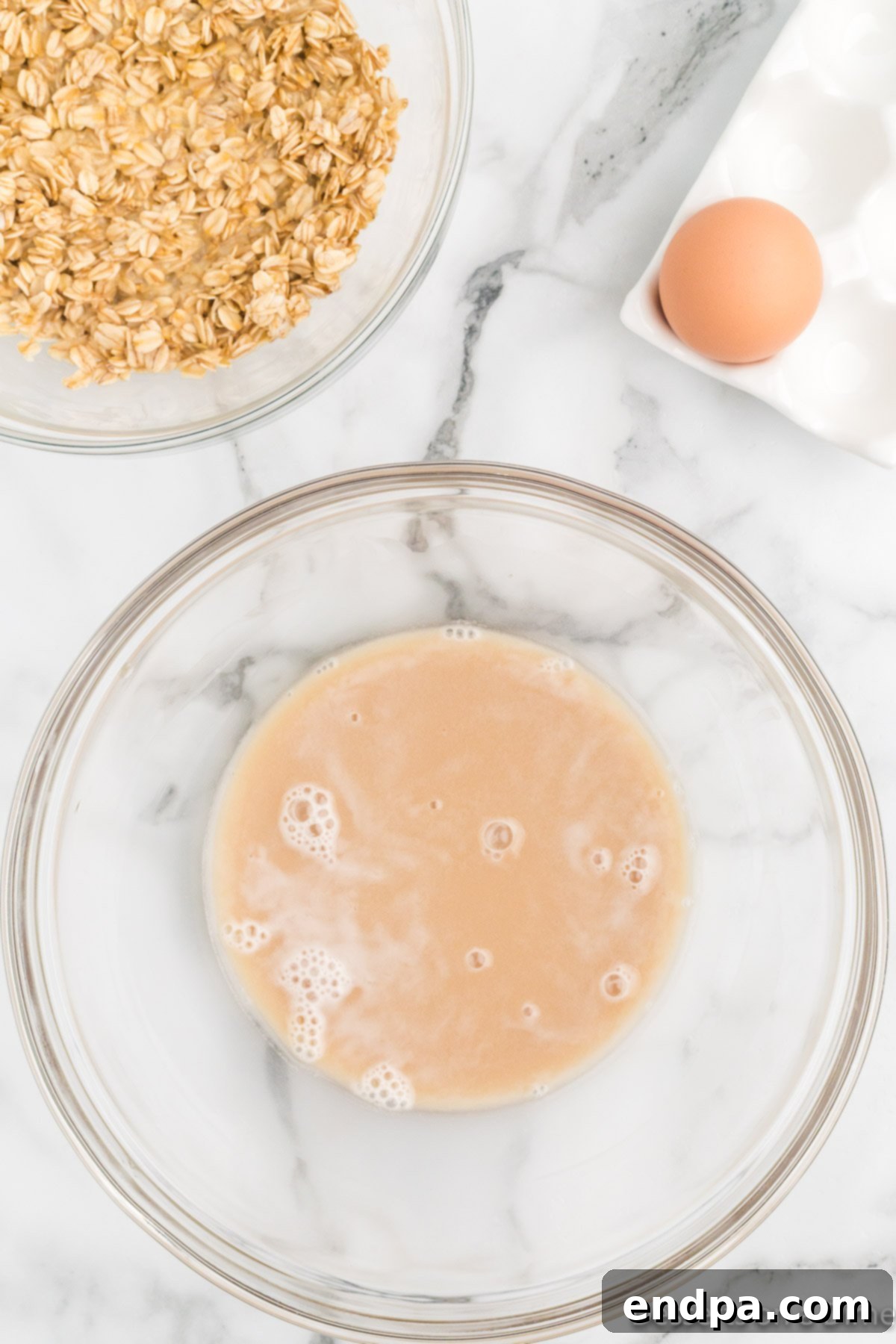
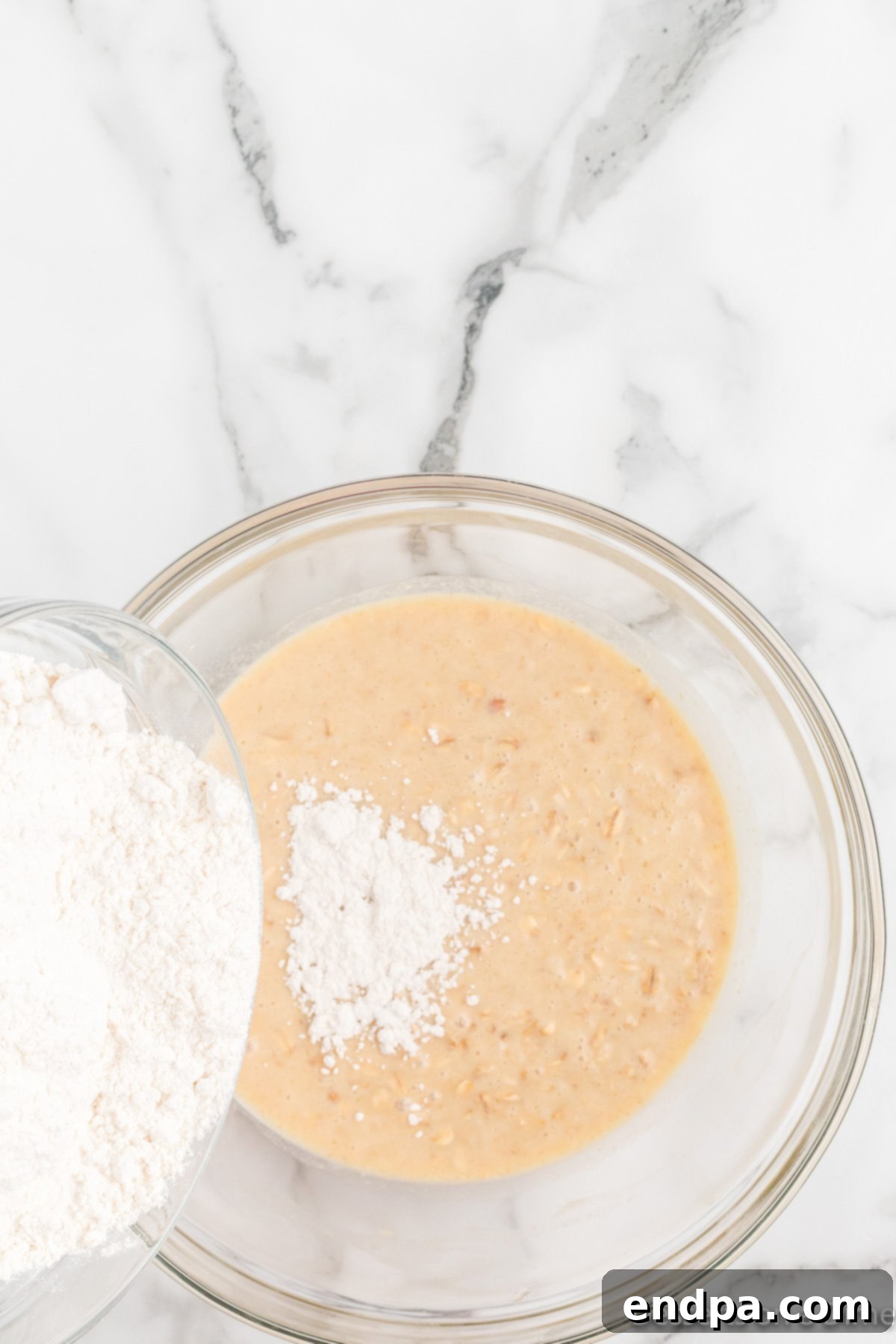
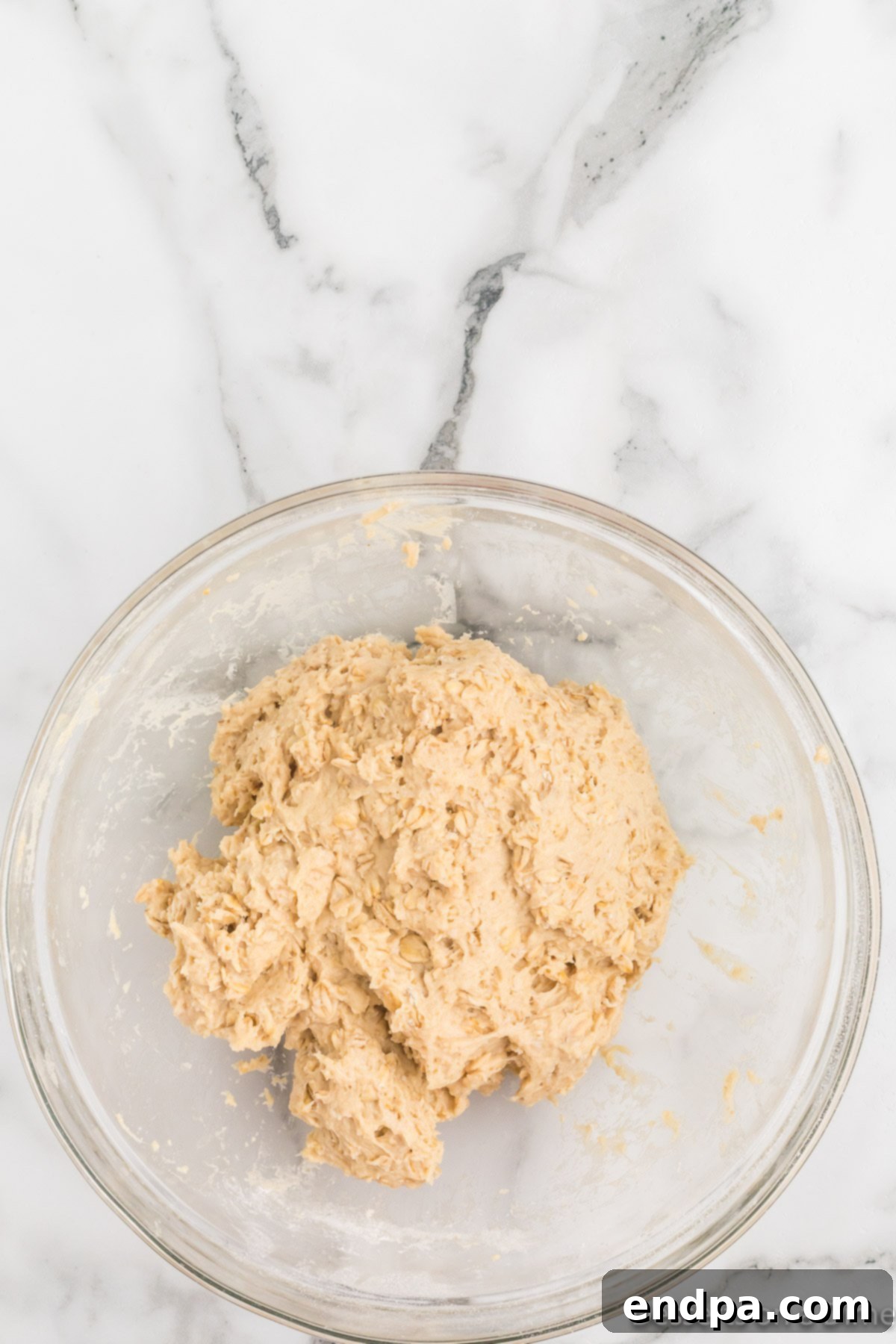

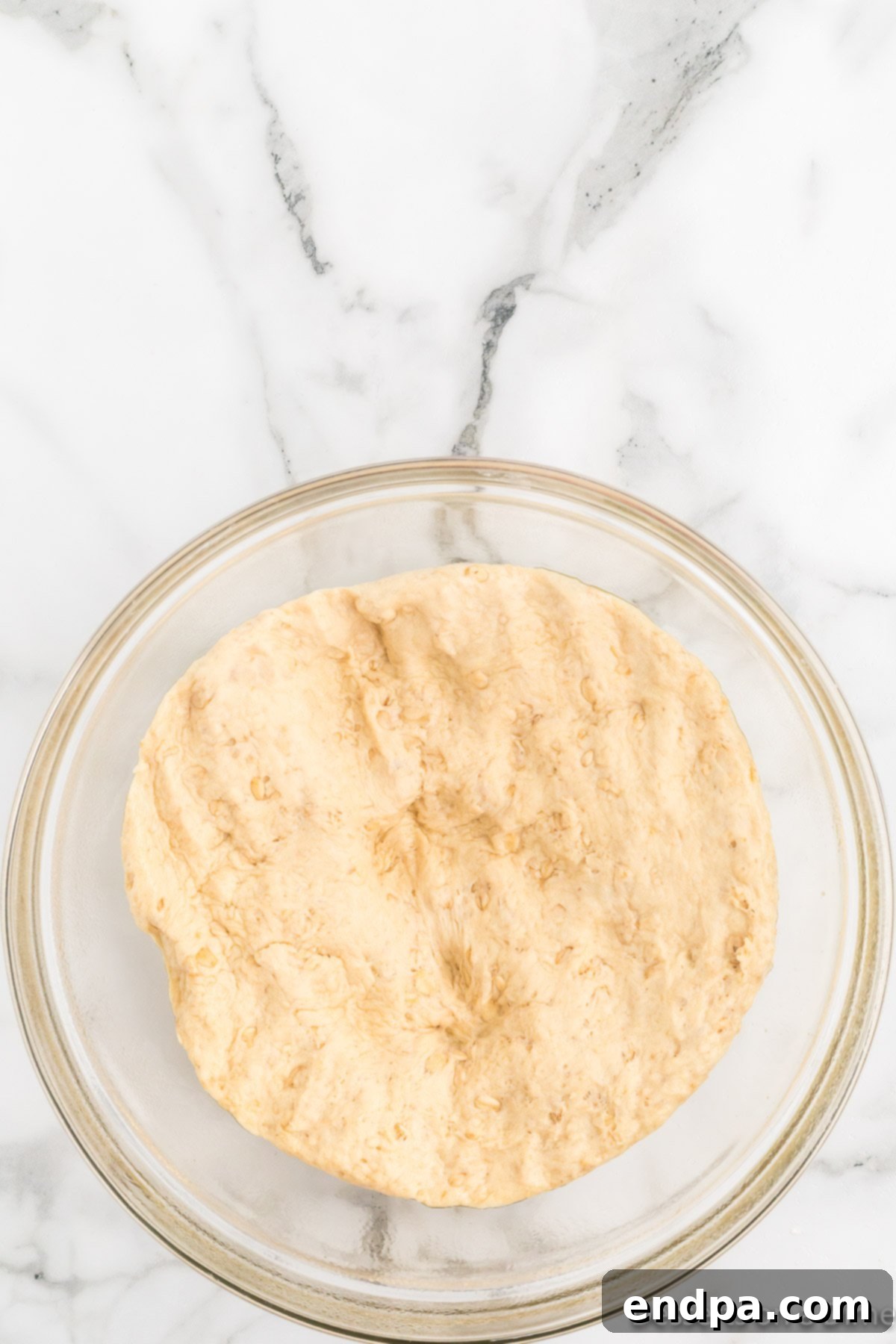
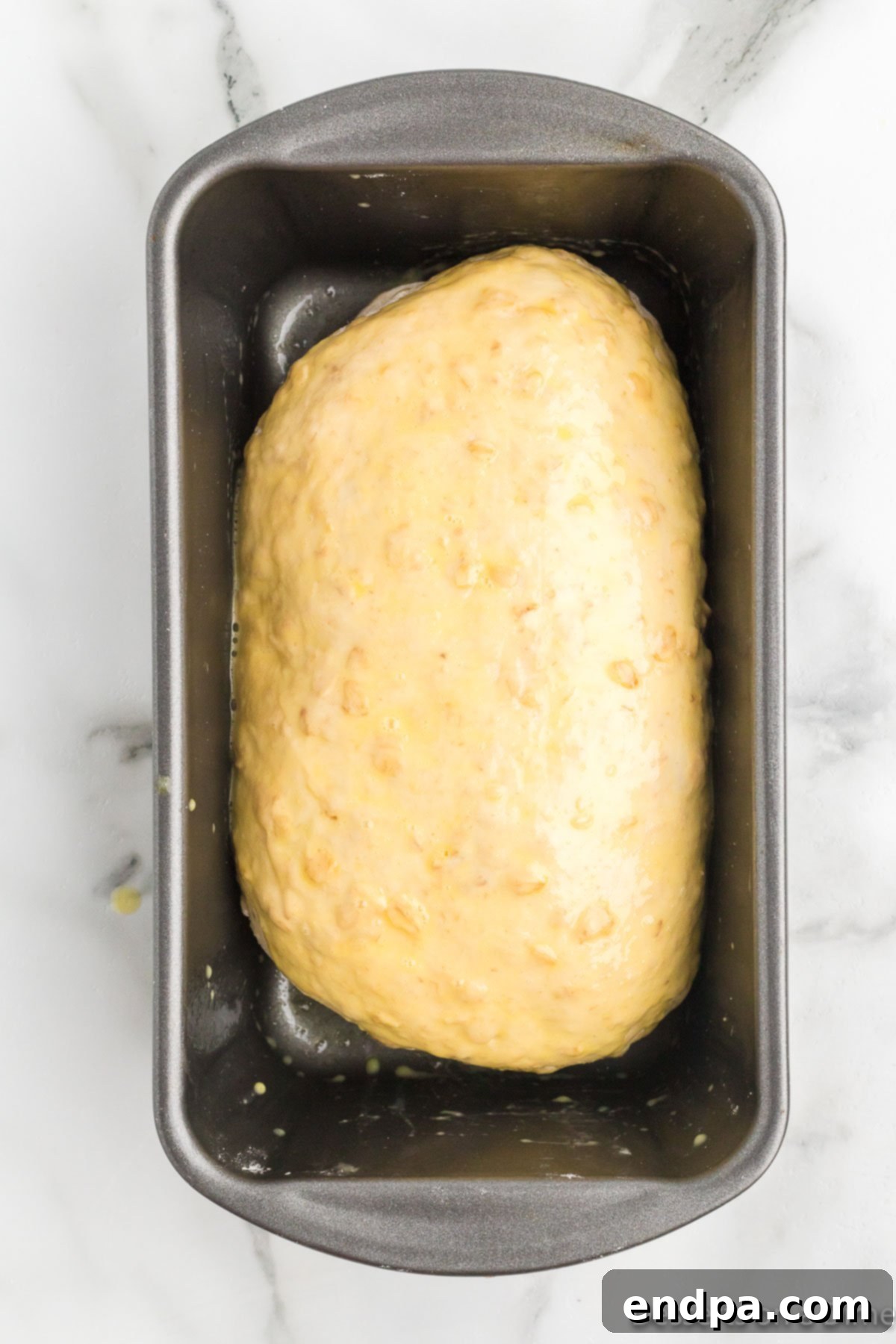
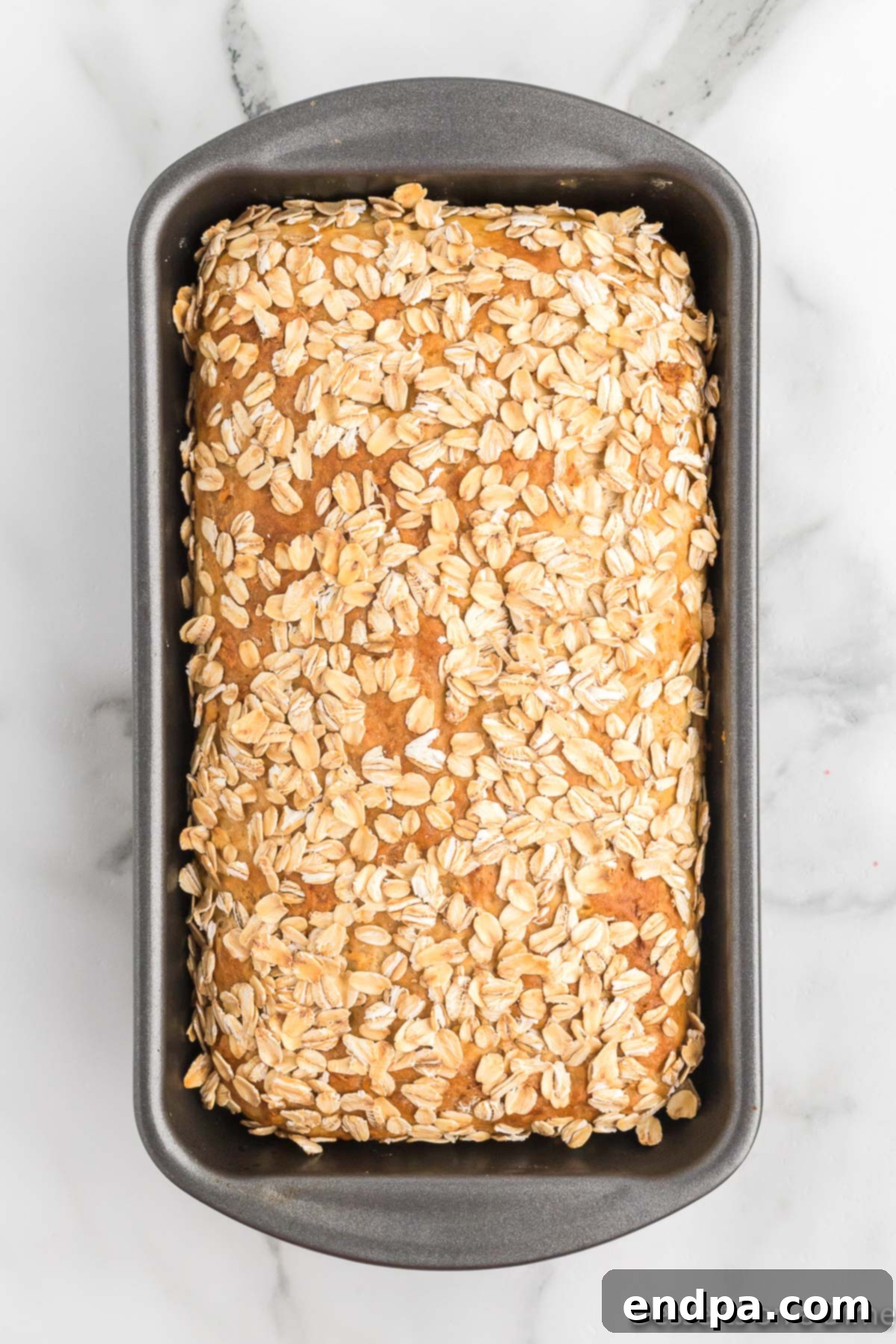
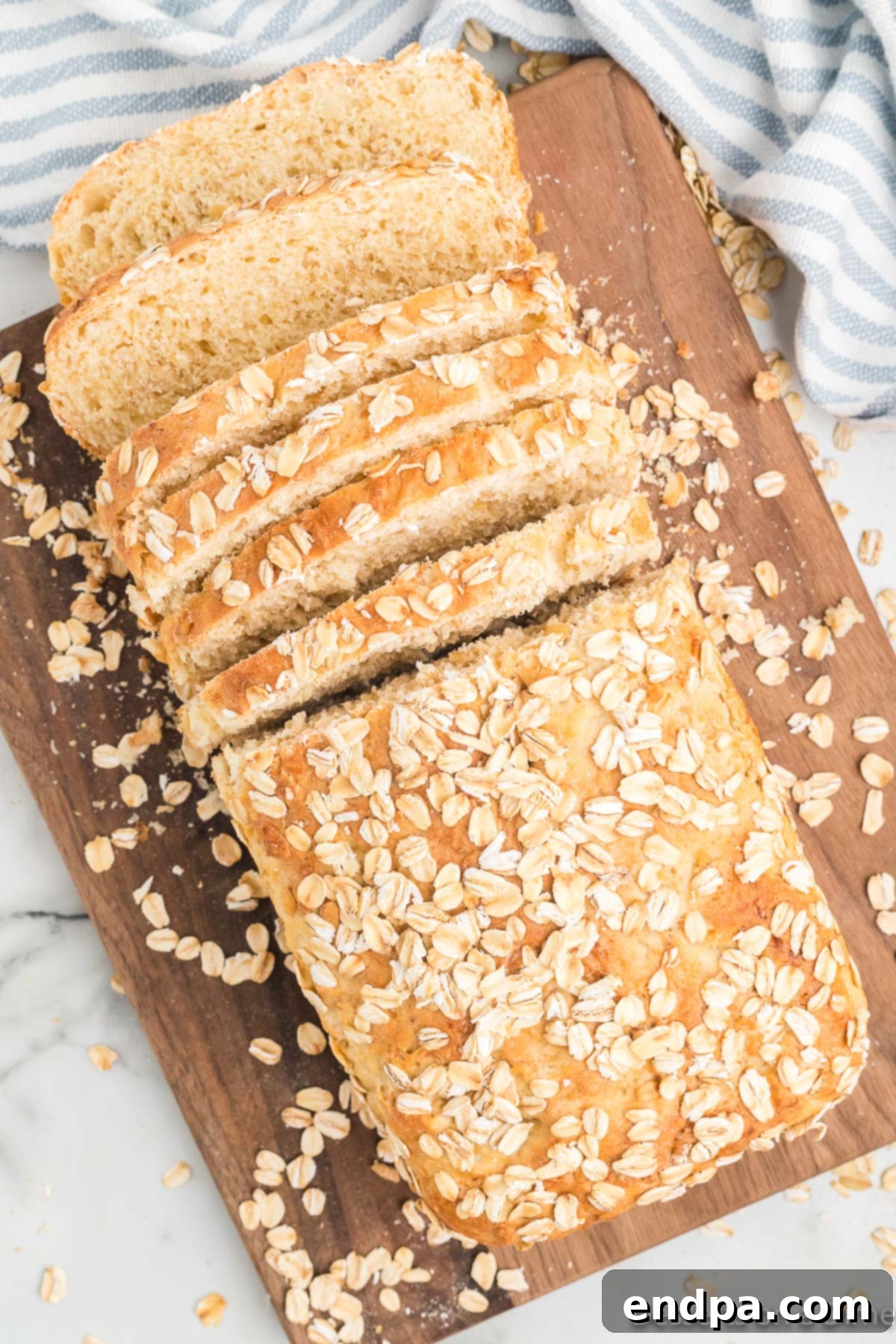
Troubleshooting Common Bread Baking Issues
Even experienced bakers encounter challenges, but don’t worry! Here are solutions to common bread baking problems:
- **Bread Didn’t Rise:**
- **Inactive Yeast:** Ensure your yeast is fresh and the water temperature for activation is between 105-115°F (40-46°C).
- **Cold Environment:** Yeast needs warmth to thrive. Find a warm, draft-free spot for rising.
- **Too Much Salt:** Excessive salt can inhibit yeast activity. Measure carefully.
- **Dense/Heavy Bread:**
- **Not Enough Kneading:** Proper kneading develops gluten, which creates a light, airy structure.
- **Not Enough Rise Time:** Allow the dough ample time to double in size during both rises.
- **Too Much Flour:** Over-flouring makes the dough stiff and dense. Add flour gradually until just combined.
- **Dry Bread:**
- **Over-baking:** Use a thermometer to check for doneness (200-210°F/93-99°C).
- **Not Enough Liquid:** Ensure you’re adding the correct amount of milk and water.
- **Crust Too Hard/Thick:**
- **Over-baking:** Again, temperature is key.
- **Low Humidity in Oven:** A pan of hot water on the bottom rack can create steam for a softer crust.
Serving Suggestions for Your Freshly Baked Loaf
This versatile oatmeal bread is delicious in so many ways. Here are a few serving suggestions to inspire you:
- **Classic Toast:** Slice it thick, toast it to golden perfection, and slather with butter, jam, or marmalade for a classic breakfast or snack.
- **Hearty Sandwiches:** Its sturdy yet soft texture makes it ideal for both savory and sweet sandwiches. Think turkey and cheese, or even peanut butter and banana.
- **French Toast:** Day-old oatmeal bread makes incredible French toast, soaking up the custard mixture beautifully.
- **With Soup or Stew:** Serve slices alongside a warm bowl of your favorite soup or stew for a comforting and complete meal.
- **Sweet Treat:** Drizzle with extra honey, a sprinkle of cinnamon, or a dollop of apple butter for a simple dessert.
- **Bruschetta Base:** Toast thin slices, rub with garlic, and top with fresh tomatoes and basil for an unexpected appetizer.
Storage and Freezing Made Easy
Proper storage ensures your homemade oatmeal bread stays fresh and delicious for as long as possible:
How to Store Your Oatmeal Bread
This homemade oat bread recipe will keep beautifully in an airtight container or a bread box at room temperature for up to 3 days. To maintain its freshness, you can also wrap the cooled loaf tightly in plastic wrap before placing it in the container. Avoid refrigerating yeast breads, as this can often dry them out and make them stale more quickly.
Can You Freeze the Bread?
Absolutely, freezing is a fantastic way to preserve your oatmeal bread, especially if you’ve baked an extra loaf! Allow the bread to cool completely to room temperature before freezing. This prevents ice crystals from forming inside the loaf, which can lead to a soggy texture upon thawing.
To freeze, wrap the entire loaf or individual slices securely in parchment paper, then in aluminum foil, and finally place it inside a freezer bag or airtight freezer-safe container. This triple-layer protection helps prevent freezer burn. It can be frozen for up to 3 months.
When you’re ready to enjoy, simply allow the bread to thaw in the refrigerator overnight, or on the counter for a few hours. For a warm, fresh-from-the-oven experience, you can gently reheat thawed slices in a toaster or a preheated oven.
Frequently Asked Questions About Oatmeal Bread
For the best texture and flavor in this yeast bread, use old-fashioned rolled oats. Quick or instant oats cook differently and might result in a gummier texture in the finished bread. Steel-cut oats are too tough for this recipe.
Several factors can lead to dense bread: inactive yeast, not enough kneading (which develops gluten), adding too much flour, or not allowing enough time for the dough to rise adequately during both the first and second fermentations. Ensure your yeast is active and your rising environment is warm.
Yes, you can substitute a portion of the all-purpose flour with whole wheat flour. We recommend starting by replacing up to 50% of the all-purpose flour. Keep in mind that whole wheat flour absorbs more liquid, so you might need to add an extra tablespoon or two of milk or water to achieve the right dough consistency.
When you add dry active yeast to warm water (around 105-115°F or 40-46°C) with a pinch of sugar (or honey, as in this recipe), it should become foamy and bubbly within 5-10 minutes. If it doesn’t foam, your yeast is likely old or dead, and you should get new yeast before proceeding with the recipe.
The rising time can vary greatly depending on the temperature of your kitchen. The first rise (bulk fermentation) typically takes 1 to 2 hours, and the second rise (proofing) takes 45 minutes to 1.5 hours. Look for the dough to double in size, rather than adhering strictly to time limits.
More Delicious Bread Recipes to Explore
If you loved baking this wholesome oatmeal bread, you might enjoy trying these other fantastic bread recipes:
- Banana Bread with Applesauce
- Classic Sweet Bread
- Copycat Starbucks Lemon Loaf Recipe
- Festive Orange Cranberry Bread
- Oatmeal Banana Quick Bread
We hope you make this homemade oatmeal bread for a truly delicious and satisfying baking experience. It’s a recipe everyone will love. After you’ve tried it, please come back and leave a star rating and a comment to share your experience!
Wholesome Honey Oatmeal Bread
25 mins (active) + 1-2 hours (soaking oats)
2-3 hours (total for two rises)
30-40 mins
Approx. 4-5 hours (including soaking & rising)
1 standard loaf (12 slices)
American
Breakfast, Snack, Side
Carrie Barnard
Ingredients
For the Bread:
- 1 ½ cups old-fashioned rolled oats
- ¼ cup unsalted butter, softened
- 1 cup milk, scalded and cooled to warm
- ½ cup warm water (105-115°F / 40-46°C)
- 2 ¼ teaspoons active dry yeast (one standard packet)
- 3 ½ – 4 cups all-purpose flour, plus more for dusting
- ¼ cup honey
- 1 ½ teaspoons salt
- 1 large egg, room temperature
For the Topping:
- 1 large egg
- 1 tablespoon water
- 1 tablespoon old-fashioned rolled oats
Instructions
- Prepare Loaf Pan: Lightly grease a 9×5-inch loaf pan or line it with parchment paper, leaving an overhang on the long sides. Set aside.
- Soak Oats: In a large mixing bowl, combine the 1 ½ cups rolled oats and softened butter. Scald the milk by bringing it to a low simmer on the stovetop, then cool it down until it’s just warm. Pour the warm milk over the oats and butter, stir, and let the mixture cool to room temperature (about 1-2 hours).
- Activate Yeast: In a separate large mixing bowl, pour in the warm water. Sprinkle the dry active yeast over the water, stir gently, and let it sit for 5 minutes until foamy.
- Combine Wet Ingredients: To the activated yeast, add the honey, 1 teaspoon of the salt, the cooled oat-butter-milk mixture, and the room-temperature egg. Mix well until thoroughly combined.
- Add Flour: Gradually add the all-purpose flour (starting with 3 ½ cups) to the wet ingredients, mixing on low speed with a dough hook or by hand until a shaggy dough forms. If needed, add the remaining ½ cup flour, a little at a time, until the dough comes together. Mix in the remaining ½ teaspoon of salt.
- Knead Dough: Increase mixer speed to medium-low and knead for 5-7 minutes, or knead by hand on a lightly floured surface for 8-10 minutes, until the dough is smooth and elastic. Form into a ball, place in a lightly greased bowl, and turn to coat.
- First Rise: Cover the bowl with plastic wrap or a clean towel and let it rise in a warm, draft-free place for 1 to 2 hours, or until doubled in size.
- Shape Loaf: Gently punch down the risen dough to release air. Transfer to a lightly floured surface and knead briefly (1-2 minutes). Shape the dough into a loaf and place it into the prepared loaf pan.
- Second Rise & Topping: In a small bowl, whisk the remaining egg with 1 tablespoon of water for an egg wash. Brush the top of the loaf with the egg wash and sprinkle with 1 tablespoon of rolled oats. Cover loosely and let it rise again for 45 minutes to 1.5 hours, or until nearly doubled in size and puffy (do not let it rise too high above the pan rim).
- Bake: Preheat oven to 375°F (190°C). Bake for 30-40 minutes. If the top browns too quickly, loosely tent with foil for the last 10-15 minutes. The bread is done when golden brown and the internal temperature reaches 200-210°F (93-99°C).
- Cool: Let the bread cool in the pan for 10-15 minutes before carefully removing it to a wire rack. Cool completely before slicing and serving for the best texture. Enjoy!
Recipe Notes
Ensure all ingredients are at room temperature for optimal dough development, especially the egg and milk after scalding.
